Please read the article below to answer these questions:
What is the issue or the problem to be solved?
What is the goal of the article?
What is the context of the problem?
What key facts should be/ were considered?
What alternatives are available to the decision-maker?
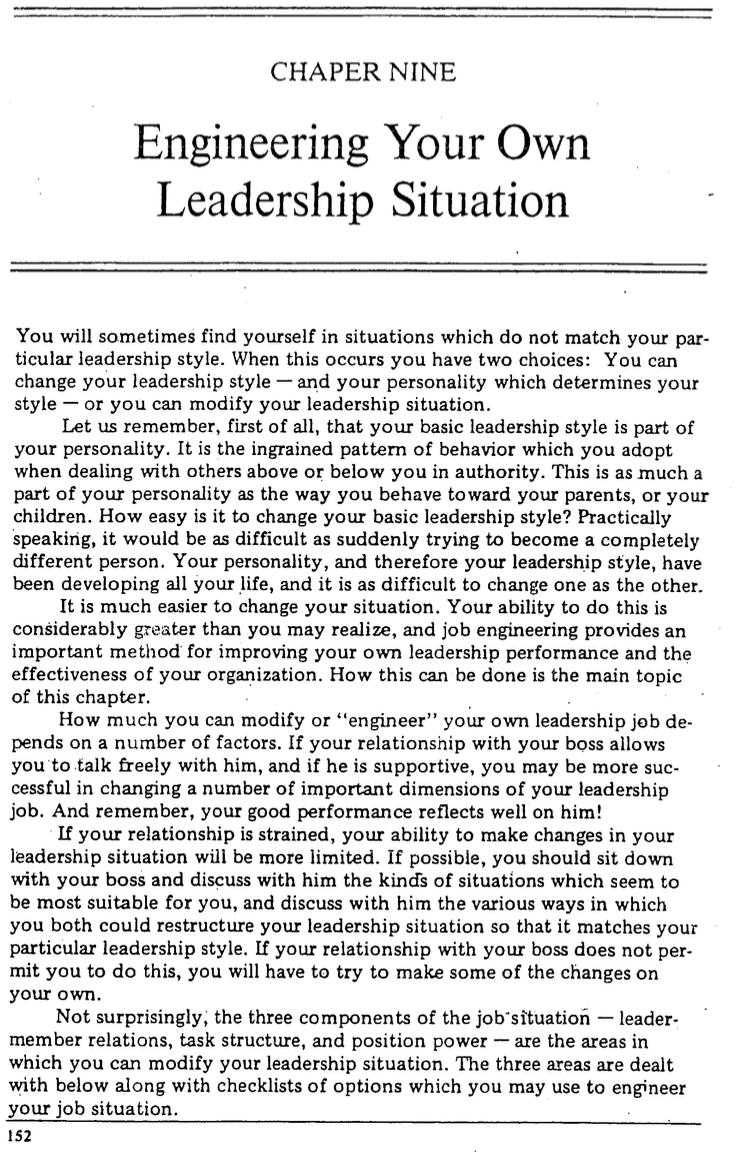
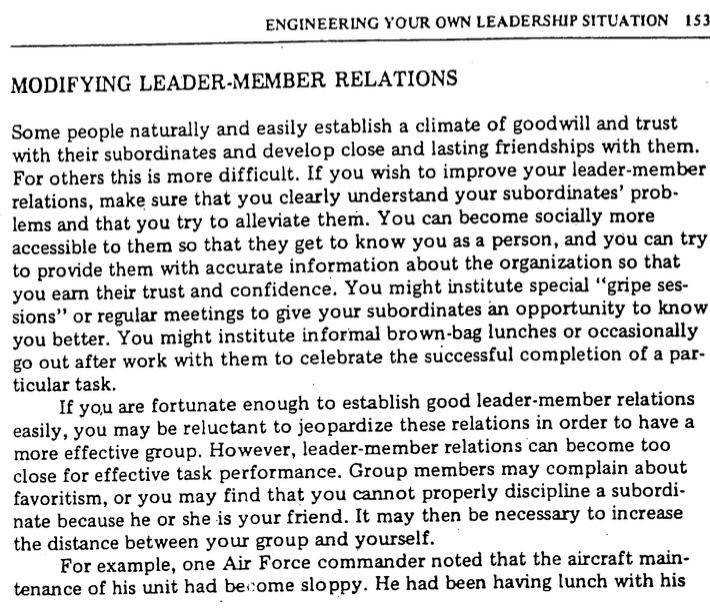
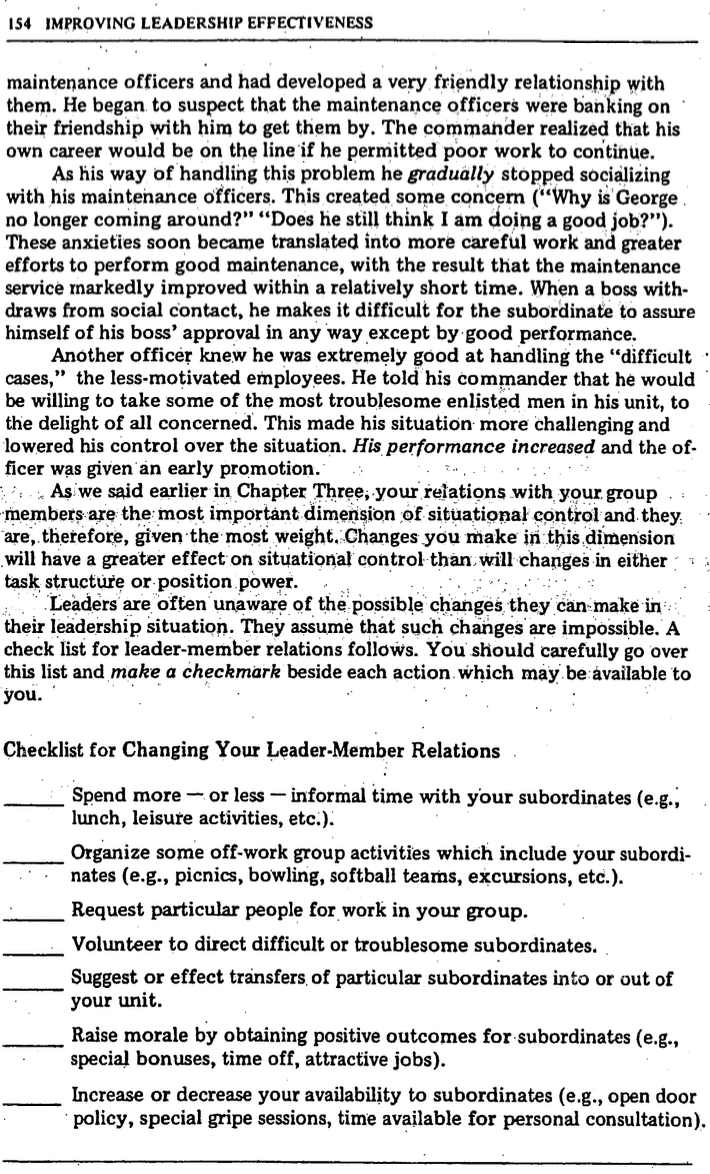
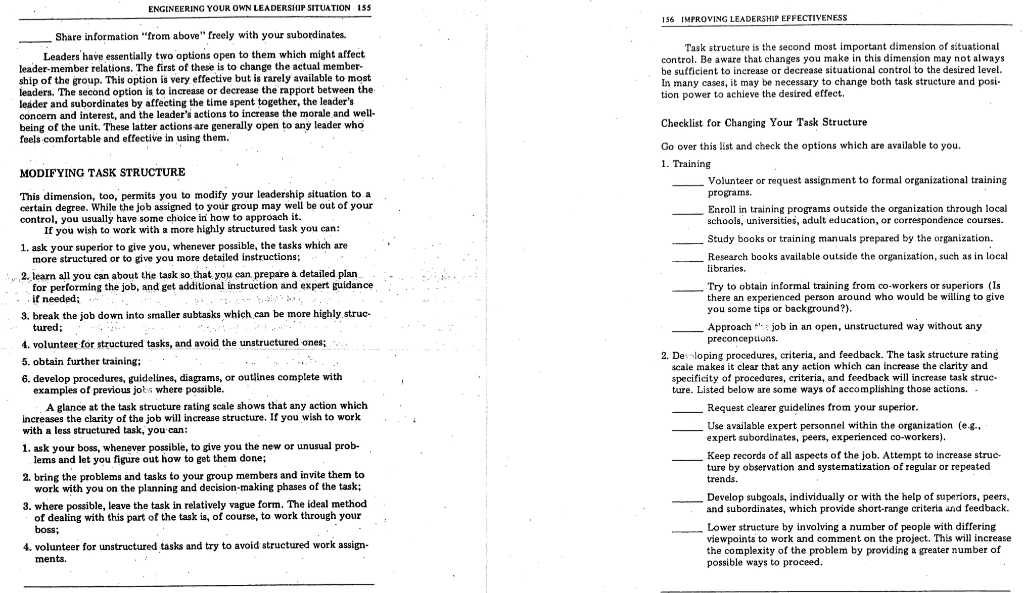
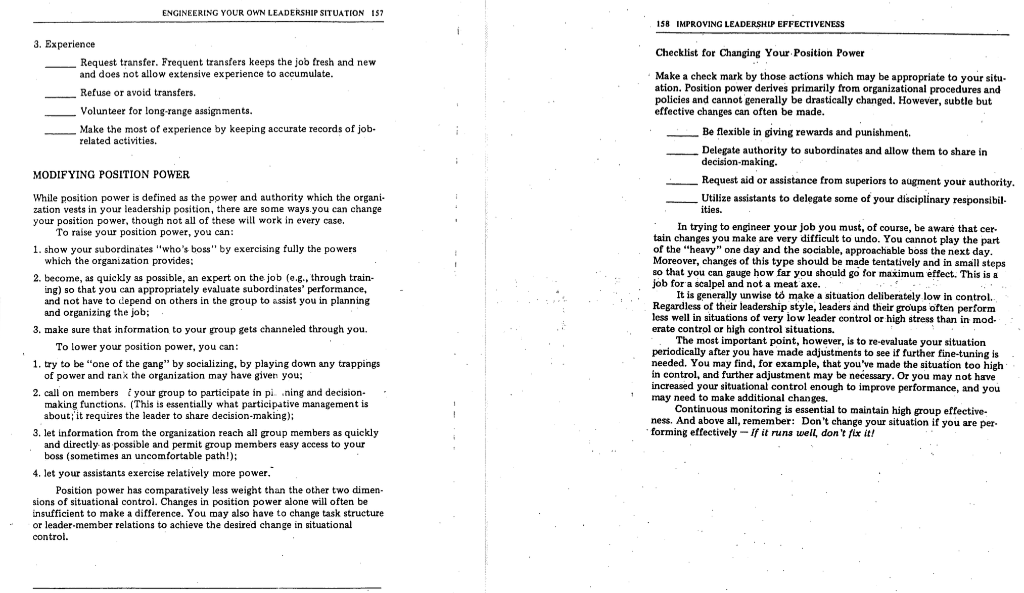
You will sometimes find yourself in situations which do not match your particular leadership style. When this occurs you have two choices: You can change your leadership style - and your personality which determines your style - or you can modify your leadership situation. Let us remember, first of all, that your basic leadership style is part of your personality. It is the ingrained pattern of behavior which you adopt when dealing with others above or below you in authority. This is as much a part of your personality as the way you behave toward your parents, or your children. How easy is it to change your basic leadership style? Practically speaking, it would be as difficult as suddenly trying to become a completely different person. Your personality, and therefore your leadership style, have been developing all your life, and it is as difficult to change one as the other. It is much easier to change your situation. Your ability to do this is considerably greater than you may realize, and job engineering provides an important method for improving your own leadership performance and the effectiveness of your organization. How this can be done is the main topic of this chapter. How much you can modify or "engineer" your own leadership job depends on a number of factors. If your relationship with your boss allows you to talk freely with him, and if he is supportive, you may be more successful in changing a number of important dimensions of your leadership job. And remember, your good performance reflects well on him! If your relationship is strained, your ability to make changes in your leadership situation will be more limited. If possible, you should sit down with your boss and discuss with him the kinds of situations which seem to be most suitable for you, and discuss with him the various ways in which you both could restructure your leadership situation so that it matches your particular leadership style. If your relationship with your boss does not permit you to do this, you will have to try to make some of the changes on your own. Not surprisingly, the three components of the job"situation - leadermember relations, task structure, and position power - are the areas in which you can modify your leadership situation. The three areas are dealt with below along with checklists of options which you may use to engineer your job situation. Some people naturally and easily establish a climate of good will and trust with their subordinates and develop close and lasting friendships with them. For others this is more difficult. If you wish to improve your leader-member relations, make sure that you clearly understand your subordinates' problems and that you try to alleviate them. You can become socially more accessible to them so that they get to know you as a person, and you can try to provide them with accurate information about the organization so that you earn their trust and confidence. You might institute special "gripe sessions" or regular meetings to give your subordinates an opportunity to know you better. You might institute informal brown-bag lunches or occasionally go out after work with them to celebrate the successful completion of a particular task. If yo,u are fortunate enough to establish good leader-member relations easily, you may be reluctant to jeopardize these relations in order to have a more effective group. However, leader-member relations can become too close for effective task performance. Group members may complain about favoritism, or you may find that you cannot properly discipline a subordinate because he or she is your friend. It may then be necessary to increase the distance between your group and yourself. For example, one Air Force commander noted that the aircraft maintenance of his unit had become sloppy. He had been having lunch with his maintenance officers and had developed a very friendly relationship with them. He began to suspect that the maintenance officers were banking on their friendship with him to get them by. The commander realized that his own career would be on the line if he permitted poor work to continue. As his way of handling this problem he gradually stopped socializing with his maintenance officers. This created some concern ("Why is George . no longer coming around?" "Does he still think I am doing a good job?"). These anxieties soon became translated into more careful work and greater efforts to perform good maintenance, with the result that the maintenance service markedly improved within a relatively short time. When a boss withdraws from social contact, he makes it difficult for the subordinate to assure himself of his boss' approval in any way except by good performance. Another officer knew he was extremely good at handling the "difficult cases," the less-motivated employees. He told his commander that he would be willing to take some of the most troublesome enlisted men in his unit, to the delight of all concerned. This made his situation more challenging and lowered his control over the situation. His performance increased and the officer was given an early promotion. As we said earlier in Chapter Three, your relations with your group members are the most important dimension of situationat control and they: are, therefore, given the most weight. Changes you make in this dimension will have a greater effect on situational control than will changes in either task structure or position power. Leaders are often unaware of the possible changes they can make in their leadership situation. They assume that such changes are impossible. A check list for leader-member relations follows. You should carefully go over this list and make a checkmark beside each action. which may be available to you. Checklist for Changing Your Leader-Member Relations Spend more - or less - informal time with your subordinates (e.g., lunch, leisure activities, etc.). Organize some off-work group activities which include your subordinates (e.g., picnics, bowling, softball teams, excursions, etc.). Request particular people for work in your group. Volunteer to direct difficult or troublesome subordinates. Suggest or effect transfers of particular subordinates into or out of your unit. Raise morale by obtaining positive outcomes for subordinates (e.g., special bonuses, time off, attractive jobs). Increase or decrease your availability to subordinates (e.g., open door policy, special gripe sessions, time available for personal consultation). ENGINEERING YOUR OWN LEADERSHIP SITUATION 155 156 IMPROVING LEADERSHIP EFFECTIVENESS Share information "from above" freely with your subordinates. Task structure is the second most important dimension of situational Leaders have essentially two options open to them which might affect leader-member relations. The first of these is to change the actual membercontrol. Be aware that changes you make in this dimension may not always ship of the group. This option is very effective but is rarely available to most be sufficient to increase or decrease situational control to the desired level. leaders. The second option is to increase or decrease the rapport between the leider and subordinates by affecting the time spent together, the leader's concem and interest, and the leader's actions to increase the morale and wellbeing of the unit. These latter actionsare generally open to any leader who In many cases, it may be necessary to change both task structure and position power to achieve the desired effect. feels comfortable and effective in using them. Checklist for Changing Your Task Structure Go over this list and check the options which are available to you. MODIFYING TASK STRUCTURE 1. Training This dimension, too, permits you to modify your leadership situation to a Volunteer or request assignment to formal organizational training certain degree. While the job assigned to your group may well be out of your control, you usually have some choice in how to approach it. programs. If you wish to work with a more highly structured tusk you can: Enroll in training programs outside the organization through local schools, universities, adult education, or correspondence courses. 1. ask your superior to give you, whenever possible, the tasks which are Study books or training manuals prepared by the organization. more structured or to give you more detailed instructions; Research books available outside the organization, such as in local 2. learn all you can about the task so that you can prepare a detailed plan libraries. for performing the job, and get additional instruction and expert guidance If needed; 3. break the job down into smaller subtasks which can be more highly strucTry to obtain informal training from co-workers or superiors (Is there an experienced person around who would be willing to give tured; you some tips or background?). 4. volunteer for structured tasks, and avoid the unstructured ones: Approach t'r job in an open, unstructured way without any 5. obtain further training; preconceptions. 6. develop procedures, guidelines, diagrams, or outlines complete with examples of previous jobs where possible. A glance at the task structure rating scale shows that any action which increases the clarity of the job will increase structure. If you wish to work with a less structured task, you can: 1. ask your boss, whenever possible, to give you the new or unusual problems and let you figure out how to get them done; 2. bring the problems and tasks to your group members and invite them to work with you on the planning and decision-making phases of the task; 3. where possible, leave the task in relatively vague form. The ideal method of dealing with this part of the task is, of course, to work through your boss; 4. volunteer for unstructured tasks and try to avoid structured work assignments. scale makes it clear that any action which can increase the clarity and specificity of procedures, criteria, and feedback will increase task structure. Listed below are some ways of accomplishing those actions. Request clearer guidelines from your superior. Use available expert personnel within the organization (e.g. expert subordinates, peers, experienced co-workers). Keep records of all aspects of the job. Attempt to increase structure by observation and systematization of regular or repeated trends. Develop subgoals, individually or with the help of superiors, peers, and subordinates, which provide short-range criteria and feedback. Lower structure by involving a number of people with differing viewpoints to work and comment on the project. This will increase the complexity of the problem by providing a greater number of possible ways to proceed. 3. Experience Checklist for Changing Your.Position Power Request transfer. Frequent transfers keeps the job fresh and new and does not allow extensive experience to accumulate. Make a check mark by those actions which may be appropriate to your situ- Refuse or avoid transfers. ation. Position power derives primarily from organizational procedures and Volunteer for long-range assignments. policies and cannot generally be drastically changed. However, subtle but Make the most of experience by keeping accurate records of jobeffective changes can often be made. related activities. Be flexible in giving rewards and punishment. Delegate authority to subordinates and allow them to share in decision-making. MODIFYING POSITION POWER Request aid or assistance from superiors to augment your authority. While position power is defined as the power and authority which the organiUtilize assistants to delegate some of your disciplinary responsibilzation vests in your leadership position, there are some ways.you can change ities. your position power, though not all of these will work in every case. To raise your position power, you can: In trying to engineer your job you must, of course, be aware that cer- 1. show your subordinates "who's boss" by exercising fully the powers tain changes you make are very difficult to undo. You cannot play the part which the organization provides: of the "heavy" one day and the sociable, approachable boss the next day. 2. become, as quickly as possible, an expert on the job ( .g, through trainMoreover, changes of this type should be made tentatively and in smaill steps ing) so that you can appropriately evaluate subordinates' performance, so that you can gauge how far you should go for maximum effect. This is a and not have to clepend on others in the group to assist you in planning job for a scalpel and not a meat axe. and organizing the job; It is generally unwise t make a situation deliberately low in control. Regardless of their leadership style, leaders and their groups often perform 3. make sure that information to your group gets channeled through you. less well in situations of very low leader control or high itress than in mod. To lower your position power, you can: 1. try to be "one of the gang" by socializing, by playing down any trappings The most important point, however, is to re-evaluate your situation of power and ranx the organization may have given you; periodically after you have made adjustments to see if further fine-tuning is needed. You may find, for example, that you've made the situation too high 2. call on members i your group to participate in pi. ning and decisionin control, and further adjustment may be necessary. Or you may not have making functions. (This is essentially what participative management is increased your situational control enough to improve performance, and you about; 'it requires the leader to share decision-making); may need to make additional changes. Continuous monitoring is essential to maintain high group effective- 3. let intormation from the organization reach all group members as quickly ness. And above all, remember: Don't change your situation if you are perand directly as possible and permit group members easy access to your boss (sometimes an uncomtortable path!); 4. let your assistants exercise relatively more power, Position power has comparatively less weight than the other two dimensions of situational control. Changes in position power alone will often be insufficient to make a difference. You may also have to change task structure or leader-member relations to achieve the desired change in situational control











